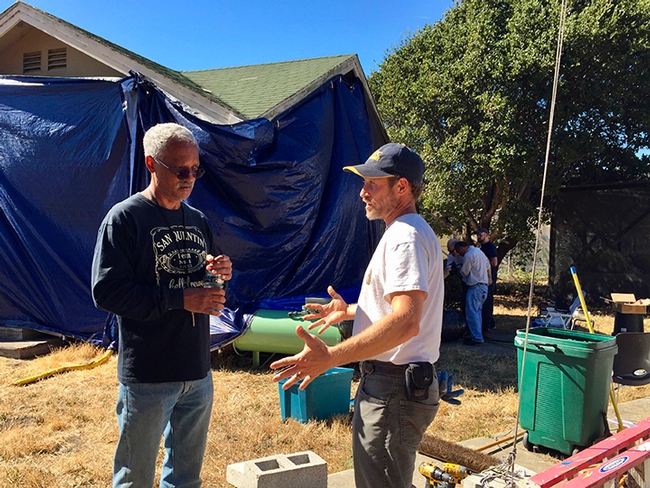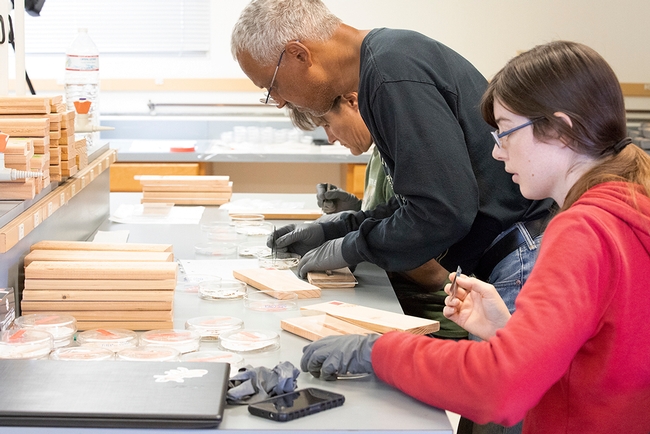- Author: Kathy Keatley Garvey
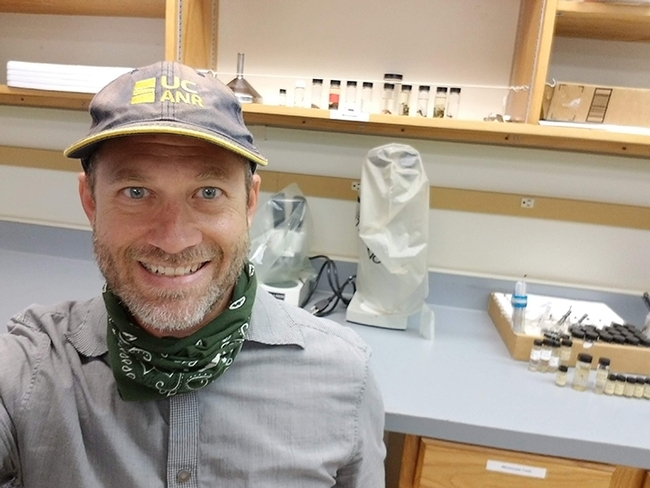
First, emeritus Cooperative Extension specialist Vernard Lewis of UC Berkeley, highly respected as "The Termite Man," drew widespread attention on Nov. 2 when he delivered the Founders' Memorial Lecture on "The Termite Lady," Margaret James Stickland Collins (1922-1966), at the Entomological Society of America's annual meeting, held in Denver.
Lewis covered the life and legacy of Collins, an African-American entomologist and civil rights advocate whose termite research spanned five decades. Lewis praised her "pioneering studies on the mechanism and evolution of termite desiccation resistance across various habitats provided foundational knowledge for generations of entomologists, field biologists, and ecologists."
Did termites fade into obscurity after Lewis' heralded ESA seminar?
No. Not a chance. "Love" saw to that.
The heavy winter rains in the Bay Area, followed by warm sunny days, resulted in the timely emergence of subterranean termites "looking for love," noted University of California Urban Integrated Pest Management (IPM) advisor and urban entomologist Andrew Sutherland, who serves the San Francisco Bay Area counties of Alameda, Contra Costa, San Francisco, San Mateo, and Santa Clara.
"Interestingly, this year's subterranean termite swarms generated way more pop media interest than usual," said Sutherland who holds a doctorate in entomology (2009) from UC Davis. "Perhaps it's because we had more people at home than in previous years (pre-COVID...also, 2019 and 2020 swarms occurred during Thanksgiving weekend, so folks may have been preoccupied or traveling)."
"Since they live underground, they have to have opportunities to meet and fall in love," Sutherland told journalist Leah Worthington of the Redwood City Pulse. "So it's kind of like a big singles bar in the air...The king and queen form what's called a nuptial pair. And that nuptial pair starts a colony, usually in a piece of wood that is partially buried in the soil."
Sutherland's program contributed to three news media pieces; a UC Agricultural and Environmental Sciences (UC ANR) blog; and a LinkedIn post:
- ABC 7 TV spot
- Redwood City Pulse story (also published in Palo Alto Online)
- San Francisco Gate story
- UC Agriculture and Natural Resources (UC ANR) blog post
- LinkedIn post
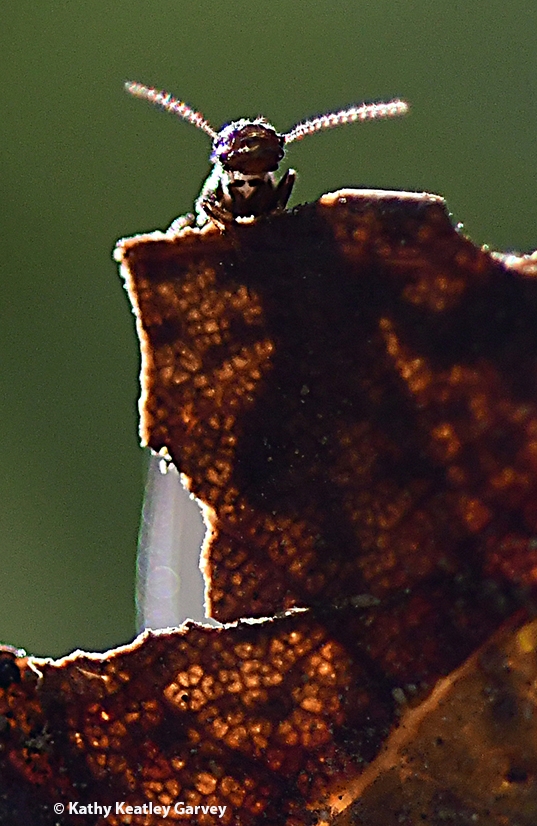
"Up here in the San Francisco Bay Area, we're continuing evaluations of bait station systems and investigations into the western subterranean termite species complex," Sutherland said.
In his UC ANR blog, published Oct. 21--in the midst of the fall subterranean termite swarm season--Sutherland explained the situation well:
"It's that time of year again: termite swarm season! Western subterranean termites, Reticulitermes hesperus (species complex), produce reproductive swarms during calm sunny periods immediately following the first autumn rains. This is especially pronounced in the San Francisco Bay Area and parts of the Sacramento Valley, where mature termite colonies across a broad region may swarm simultaneously en masse, filling the air with termites fluttering their gossamer wings and filling social media discussions with wonder, horror, confusion, and dread."
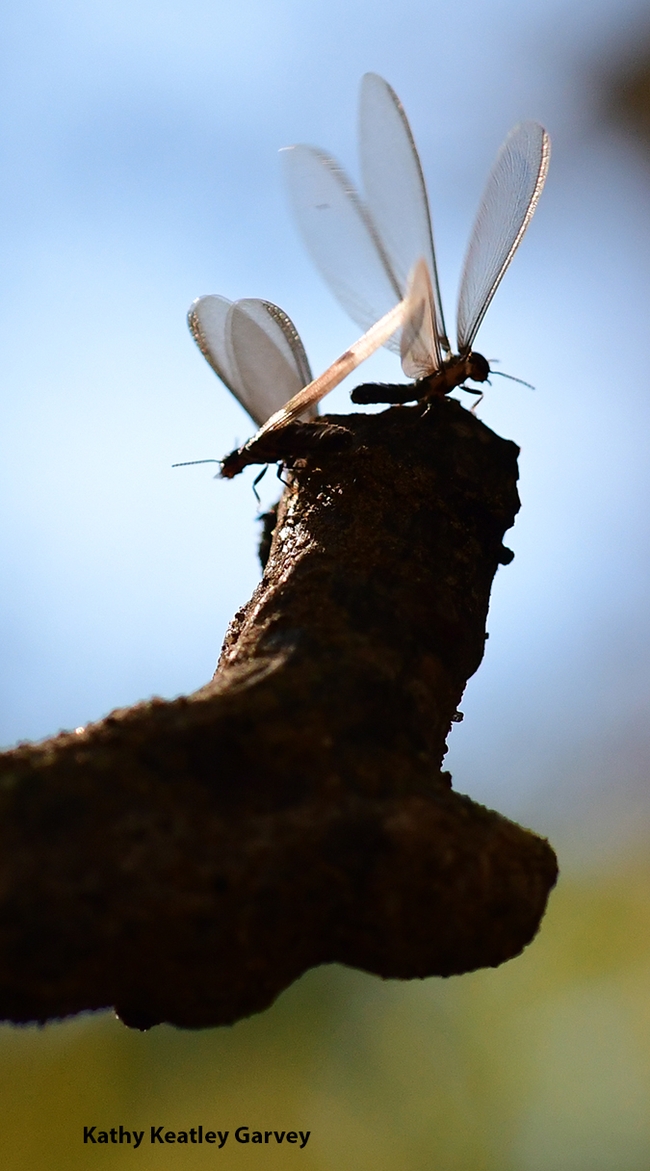
A Solano County homeowner witnessed the phenomenon on Oct. 27. She saw hundreds of them exiting the soil by her ailing black walnut tree on Buck Avenue, Vacaville. The insects literally carpeted the ground and sprawled out on fallen leaves. As the sun warmed their flight muscles, the winged termites took off--right into the beaks of swooping birds.
What should you do if you spot a swarm?
As Sutherland wrote in his blog: "If observing a swarm on your property, especially if near your home or other structures, you can hire a professional termite company for a detailed inspection. Make sure to photograph or otherwise note the swarm location so that the inspector can start there. Even if you don't see swarms on your property, regular (every three to five years) inspections will help detect infestations before they cause significant damage and prevent future infestations. There are several proven management strategies for termites; review UC IPM's Pest Notes: Subterranean Termites."
"For now, perhaps we can all appreciate the wonder of this natural spectacle," Sutherland wrote. "Winged termites are great sources of food for birds, lizards, other insects, and spiders. Termites also provide important ecosystem services, such as decomposition of wood and fallen leaves, contribution to soil structure formation, enhancement of water infiltration in soil, and facilitation of nutrient availability to plants. Furthermore, western subterranean termites are native to California and have been here long before we built wooden structures on top of their colonies. (Termite) love is in the air!
The UC IPM Pest Note relates that "Subterranean termites are common throughout California and can be found infesting fallen trees, stumps, or other dead wood in contact with the soil in the forest, landscape, or structural lumber in our houses...The most common subterranean termites, Reticulitermes, can be encountered in nearly all regions of the state, from the sand dunes of the coast to the upper elevations of the mountain ranges and even in some of the desert areas. The species of Reticulitermes are the most destructive termites found in California. They are small in size compared to dampwood and drywood termites, but mature colonies can contain hundreds of thousands of individuals."
Urban entomologist Thomas Chouvenc of the University of Florida wrote about controlling termites in his article, "Killing It in the Eggs: A Termite Bait Story," published Dec. 7 in ESA's Entomology Today. "Subterranean termites represent a legitimate concern for many homeowners in the United States because of their potential damage to wood structures," he began and went on to discuss chitin synthesis inhibitor (CSI) bait formulations.
CSI is something that termites looking for love want no part of.
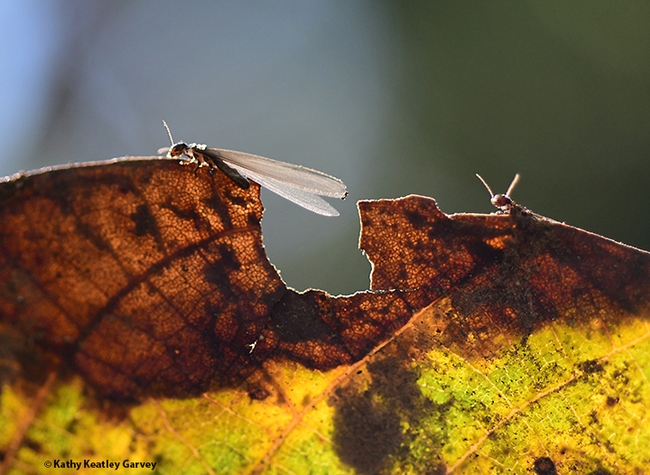
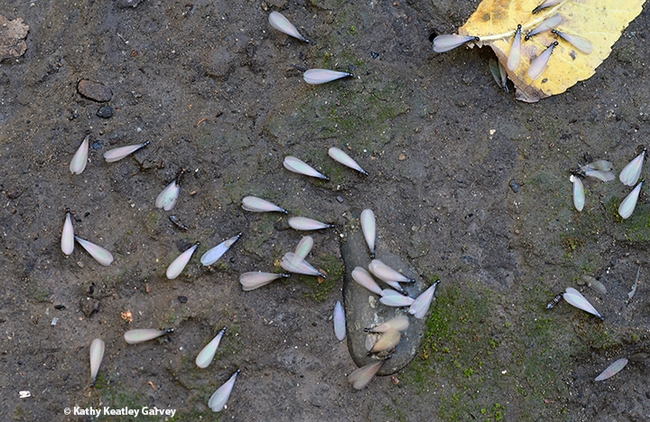
- Author: Kathy Keatley Garvey

Lewis will cover the life and legacy of African-American entomologist and civil rights advocate Margaret Collins (1922-1996) at his presentation on Tuesday morning, Nov. 2. The long-awaited conference will be hybrid, that is, both virtual and in-person.
Collins will be "the fourth woman and second Black entomologist to be the subject of the Founders' Memorial lecture in the award's 64-year history," according to an ESA news release. (See list of previous recipients.)
'The Termite Man'
Vernard Lewis, who holds a doctorate in entomology (1989) from UC Berkeley, is a recognized national and international authority on drywood termites. He is known for his pioneering research on detection innovations and nonchemical methods of control. Lewis joined the UC Berkeley faculty in 1990 and was the university's first African-American faculty-member hired in the 150-year history of the Rausser College of Natural Resources. He retired July 1, 2017 from a 35-year career as an urban entomologist, the last 26 years as a Cooperative Extension specialist. As Lynn Kimsey, director of the UC Davis Bohart Museum of Entomology and UC Davis distinguished professor of entomology told us in a Bug Squad blog in July 2017: "He was the best; knowledgeable, personable and engaged. I'm really annoyed that he retired."
"He was always the go-to person in Extension when it came to termites, and he had that special personality which enabled him to immediately engage with people," related UC Davis distinguished professor Frank Zalom, a past president of the 7000-member ESA. "I always got the feeling that he genuinely liked what he did, and it showed."
During his career, Lewis focused his research on a variety of urban pests, including not only termites, but ants, bed bugs, cockroaches and wood-boring insects. He authored more than 150 refereed and trade magazine articles and book chapters on termites and other household insect pests. He delivered more than 700 presentations to widespread audiences. Lewis was inducted into the National Pest Management Association Hall of Fame in 2016. Since achieving emeritus, he has been spending his time on university and industry committees and public boards dedicated to increasing diversity, equity, and inclusion for underrepresented minorities and women into STEM careers.
In June 2020, Brite Energy Innovators paid tribute to Lewis as one of the world's Amazing Black Scientists. An excerpt: "At UC Berkeley, Lewis famously constructed a 400-square-foot (37-square-meter) wooden building near the campus for investigating pest insect detection and control; The structure was affectionately known as 'Villa Termiti.' Built in 1993, the building temporarily housed rotating communities of bedbugs, termites, beetles and ants, while Lewis and other scientists studied the insects' habits and tested their resistance to different methods of extermination. These included exposure to X-rays, microwaves, liquid nitrogen and fumigation, according to UC Berkeley."
Another excerpt from Amazing Black Scientists: "Lewis also worked to promote diversity in entomology, and participated in outreach programs to introduce underserved youth to life sciences, insects and biodiversity." He was one of 20 researchers featured in ESA's 2015 book “Memoirs of Black Entomologists,” designed to encourage minority students to pursue careers in science.
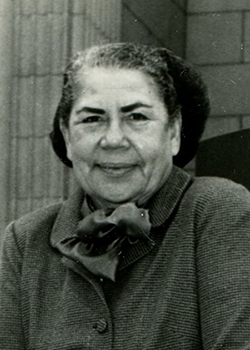
Margaret James Strickland Collins was known as "The Termite Lady" during her entomological career that spanned five decades. She engaged in extensive research on termites that included identifying a new species, Neotermes luykxi. "Her pioneering studies on the mechanism and evolution of termite desiccation resistance across various habitats provided foundational knowledge for generations of entomologists, field biologists, and ecologists," said Lewis, who wrote about her in a piece published June 1, 2016 in BioOne journal.
His abstract: "Often legends go unrecognized for their achievements in science and the betterment of society. In the case of Margaret Collins, it has been almost 20 years since her passing, and except for appreciation by a small cadre of termite experts, her contributions to entomology have received scant notice. However, her work and legacy have stood the test of time, and even today, she is considered, and often cited as, the definitive source for differences in toleration and resistance to drying among species of termites. At her core, Margaret was a field biologist, and she demonstrated it through her travels and termite collection trips to a dozen countries. Her long and illustrious career included publishing of scientific papers, tenured faculty positions, and service as a curator of the termite collection at the National Museum of Natural History, Smithsonian Institution, in Washington, District of Columbia. Margaret achieved many firsts during her life. She was the first African American female to be awarded a Ph.D. involving entomology at a major university. In addition, she was the first woman graduate student for the legendary isopterist and Professor of Zoology, Alfred E. Emerson. Her passion for termites remains highly visible in her published works. Her passion for her family and her strong support of civil rights for women and African Americans were less visible except to those she knew personally."'
Born in Institute, W.Va., on Sept. 4, 1922, Margaret was recognized as a child prodigy at age 6, "as evidenced by her being awarded the privilege to check out books at the West Virginia State College Library," Lewis wrote in the journal article. Following her high school graduation at age 14, she went on to receive her bachelor's degree in biology from West Virginia State College in 1943, and her doctorate in zoology in 1949 from the University of Chicago. Her thesis: Differences in Toleration of Drying among Species of Termites (Reticulitermes).
Collins was one of the first African-American women to receive an advanced degree related to zoology/entomology. "Those of us with collegiate degrees are well aware of the challenges and obstacles that can drain enthusiasm and delay completion, which include lack of funding, being away from home, and difficult and demanding courses and class loads," Lewis wrote. "Margaret had all of these, plus more."
"Upon receiving her Ph.D. in 1950 at the University of Chicago, Collins became the first African-American female entomologist," Lewis noted. "In the mid-'50s while on the faculty of Florida A&M, her invitation to speak at a local predominantly white university on biology and equity was cancelled due to a bomb threat. During the Florida A&M Student Council bus boycott of 1955 to protest racial inequality, Dr. Collins volunteered to drive people to work. These activities led to her being closely watched by the police and FBI."
In 1979, Collins coordinated an American Association for the Advancement of Science symposium on "Science and the Question of Human Equality," and later that year, published a book with the same title. The book is "an interdisciplinary look at racism and science, investigating the biological and social realities of individual and group differences," according to the publisher.
Love of Science
Just like Margaret Collins, Lewis shares a love of termites, a love of science, and a love of public service. In the ESA news release, ESA President Michelle S. Smith praised Lewis for his "remarkable career in both research and extension" and as "a role model for current and future generations of insect scientists. His pioneering spirit echoes that of Dr. Margaret Collins, and her story of determination, curiosity, and perseverance will be a perfect complement to our annual meeting showcasing adaptation and transformation in insect science."
The ESA meeting is appropriately themed "Adapt. Advance. Transform."
Yes! "Adapt. Advance. Transform." And let's add one more: "Recognize!"
We're delighted to see this much deserved recognition for two legendary entomologists.
